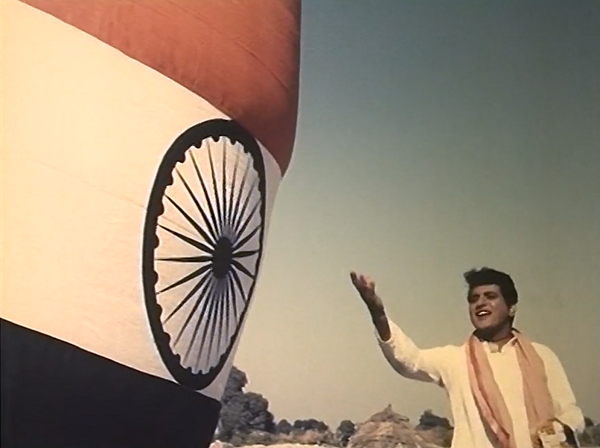A showy, chest-thumping Akshay Kumar-Vicky Kaushal variety of patriotism is in vogue, but it wasn’t a trend when Manoj Kumar introduced it to Hindi cinema. We are reminded of it every Independence Day and Republic Day, or when India wins a cricket match against Pakistan, and Mere Desh Ki Dharti from Manoj Kumar’s Upkaar (1967) is blared from loudspeakers.
Kumar died on Friday in Mumbai at the age of 87. In his movies, nationalism was of a less virulent kind – the son-of-the-soil Indian pitted against decadent Westernised desis who had abandoned Indian values. It was the mission of the star nicknamed “Mr Bharat” to bring them back to the fold, whether it was a wicked brother (Prem Chopra) in Upkar or the blonde, mini-skirted smoker and drinker (Saira Banu) in Purab Aur Paschim.
In Clerk (1989), the instrumental version of the Indian National Army song got a dying man to march again in what must be the most ridiculed sequence in Hindi cinema ever.
Harikishan Giri Goswami was born on July 24, 1937, in Abbottabad in undivided India. His family relocated to Delhi during the Partition in 1947. He had graduated from college when his cousin, Lekhraj Bhakri, came to Delhi for the premiere of his film Tangewali (1956) and told the tall and handsome young man that he looked like a hero.
He moved to Mumbai and renamed himself Manoj Kumar (supposedly inspired by Dilip Kumar’s character in the 1949 film Shabnam). He made his debut in a tiny part in his cousin’s film Fashion (1957), singing a song that had the words Mera Desh Hai Mahaan – perhaps an early indication of the way his career was headed.
Kumar did a few forgettable side roles and, it is rumoured, ghost-wrote scripts until he got a break as a leading man in Kaanch Ki Gudiya (1961). Success came after a couple of more duds with Hariyali Aur Raasta (1962) and stardom with Woh Kaun Thi (1964).

Kumar was on a roll thereafter, with such hits as Himalay Ki God Mein (1965), Shaheed (1965) and Do Badan (1966). Even though his films did well, his acting was iffy. There was the unfortunate tendency to imitate Dilip Kumar and mumble his lines through his fingers that he placed on his face in an odd style. This became his trademark, and whenever anyone mimicked him, they used that pose.
S Ram Sharma’s Shaheed (1965), in which Kumar played the revolutionary Bhagat Singh and was rumoured to have ghost-directed, was the game-changer. The actor made his debut as a director with Upkar in 1967, playing a farmer, soldier and patriotic Indian who not only serves his country but also reforms his straying brother.
Upkar changed the course of Pran’s career. From being typecast as a villain, he played the hero’s noble friend, Malang Baba, and got to sing the popular song Kasme Vaade Pyaar Wafaa Sab.
Upkar was a blockbuster, and Kalyanji-Anandji’s songs were hits. The film revealed that Kumar could catch the pulse of the times, turning the despair following the Sino-Indian war of 1962 into hope and pride. To his credit, there was no trace of anti-Pakistani jingoism in the film, which is now a requirement in any patriotic drama.

The super-success of Upkaar may just have spoiled Manoj Kumar for other filmmakers. He did act in films with other directors, but the more prominent ones were his own. His productions stood out for the innovative filming of songs and bizarre camera angles to heighten dramatic moments.
His next project was Purab Aur Paschim (1970), in which his Bharat gave wayward Indians in London a dose of cultural values. Shor (1972), about a father struggling to get his mute son to speak, was an experiment.
Roti Kapda Aur Makaan (1972), a multi-starrer in which Kumar appeared with Amitabh Bachchan, Shashi Kapoor, Zeenat Aman and Moushumi Chatterjee, was a high-powered social drama about an educated man struggling with unemployment (a major issue at the time) and trying to stay away from corruption.

Kumar’s outside projects Sanyasi (1975) and Dus Numbri (1976) were hits. He returned to direction with Kranti (1981), set during the independence movement. He cast his idol Dilip Kumar and Hema Malini.
Kranti marks Kumar’s swansong as a filmmaker, in 1984, he produced Painter Babu to launch his brother, Rajiv Goswami, and later Kalyag Aur Ramayan. His son, Kunal Goswami, was introduced in Kranti and did a few films before his career fizzled out. The other son Vishal’s debut Bharat Ka Beta never took off, though he had a brief career as a singer.
Manoj Kumar’s nadir was the deplorable Clerk (1989), which inspired numerous parodies and had no traces of the skills he had displayed in his short but fruitful innings as a writer-director. His last film, Jai Hind (1999), sank without a ripple.
Compared to other stars, Manoj Kumar did relatively fewer films – around 55 as an actor and many shelved projects – but created a distinctive identity for himself. But like many stars with recognisable mannerisms, he eventually become a target of ridicule. His fingers-on-face style was constantly mocked. When it was satirised in Farah Khan’s Om Shanti Om (2007), he took producer Shah Rukh Khan to court.
He was deservedly bestowed with a Padma Shri in 1992, the Filmfare Lifetime Achievement Award in 1999, and the Dadaseheb Phalke Award in 2016. He was also a member of the Bharatiya Janata Party.
Manoj Kumar’s greatest achievement, however, is that for a certain generation, when the word Bharat is uttered, his face is what comes to mind.











